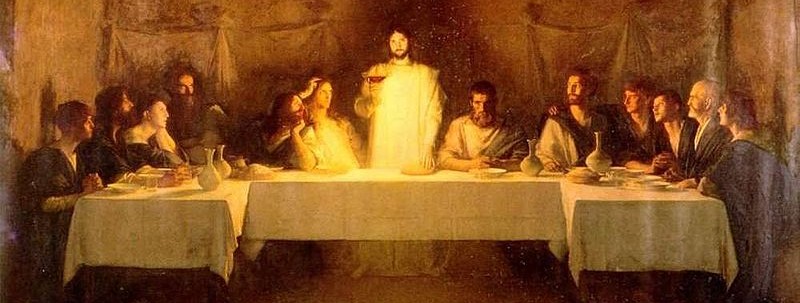Names for the Mass from the Last Supper to the Present
National Liturgical Council

Names for the Mass from the Last Supper to the Present
The Mass has been called by a number of different names through the centuries, depending on what aspect was being emphasised at the time.
In the very earliest times, Christians called it ‘the Lord’s Supper’ (1 Cor 11:20). In St Paul’s time (mid-first century), the Mass was celebrated in people’s homes after the pattern of the Last Supper when Jesus and his disciples gathered for the Jewish Passover. Another name the early Christians used for Mass was ‘the Breaking of the Bread’. (Luke 24;35 and Acts 2:42)
We might think it unusual to name the Mass after an action now so brief that it goes unnoticed. This wasn’t the case in the early Church. Christians couldn’t miss this action because real loaves were used (and the sign of peace was given earlier than it is today). When the bread was broken, they were reminded of Jesus giving his very life for the world.
This breaking of the bread also reminded them of the cross in their own lives as members of his Body, the Church. They also saw another important meaning in the one loaf broken, and the one cup shared. They remembered in this action that they were to be one in Christ until the next time they gathered at the Lord’s table. ‘The breaking of the bread’ was therefore a name that held a lot of meaning for early Christians.
The name Mass which ‘pre-Vatican II’ Catholics are probably most familiar with, comes from the Latin dismissal rite: Ite missa est. This means ‘Go, the Mass is ended’ – or more properly, ‘Go, you are sent forth.’ This brings out yet another important meaning of why we gather at the table of the Lord as the baptised Body of Christ.
We pray in the Eucharistic Prayer that the Holy Spirit will change us just like the bread and wine have been changed. We are now to be Christ’s Body in the world. We have a mission (from the same word ‘to send’) to live what we proclaim and be what we receive.
So this word ‘Mass’ is meant to remind all of us who are baptised that we celebrate on Sundays is to be lived out during the week until we gather again.
Today we often use the word Liturgy to mean the Mass, however it includes more than this. It originally came from an everyday Greek word leitourgia, meaning ‘work of the people’ joined to the work of God. Liturgy is always an action of the baptised assembly and it is always prayer.
A simple definition for ‘liturgy’ might therefore be ‘the communal worship (ritual prayer) of the Church’. In the Roman Rite, this refers to all the Church’s official prayer rituals, not only the Mass.
Since the Vatican Council, we have restored another very early (2nd Century) description for the Mass, which fell into disuse for many centuries. It is of course Eucharist. It comes from another Greek word, eucharistia, which means ‘thanksgiving’. This name is very apt because here we give thanks for all God’s marvellous deeds, and especially the life, death and resurrection of Jesus Christ.
Strictly speaking, Eucharist is the name for the whole of Mass and not just Holy Communion. Even though we often speak about ‘receiving the Eucharist’ this is only a part, though a very integral part, of what we do when we celebrate Mass.
These then, are some of the more familiar names the Church has given to that most sacred work that Christians have been doing every Sunday for more than 2000 years; a Mystery so profound that no name can ever fully describe it.
This article was originally published in Let’s Walk Through The Mass. © Diocese of Parramatta. 1999, 2000, 2007. Reprinted with permission.
Image Attribution - The Last Supper, Pascal Dagnan-Bouveret
